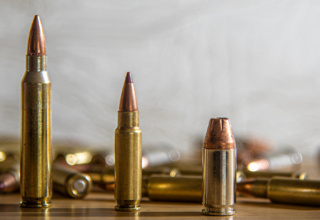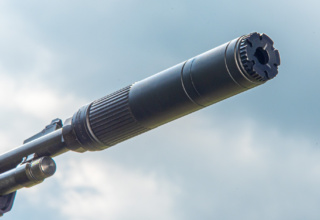When hunters outnumber gobblers on public land, all is not lost. Here’s what you need to know when the competition is “out there.”
by Larry Case
“Bud, let me tell you something. If you think I am going back down into that blue gorge after that turkey, you are crazy as an outhouse rat!”
My hunting buddy was clinging to a sapling and trying to take in enough oxygen as we labored up the steep hillside. Sweat was dripping off the end of his nose; he was red faced and none too happy.
I got the message. We had spent all morning chasing a smart-aleck gobbler that had gobbled a total of two times, lured us into the canyon, and then promptly shut up. Who said turkey hunting was fun? It wasn’t us on this day.
Any turkey hunter likes to run into the occasional “easy” gobbler. This turkey gobbles his head off on the roost, answers all your calls, and then flies down and comes to you on a string. Great. Fine. But real turkey hunters know it does not happen that way very often. Hunting gobblers that have a lot experience around hunters and turkeys that have seen a lot of pressure, especially on public land, definitely separates the men from the boys.
The Public Land Dilemma
The first thing any turkey hunter needs is a place to hunt. We are blessed with a lot of public hunting land in America. Yet with spring gobbler hunting, you need a little privacy — more so than when rabbit or bird hunting. Several hunters in a confined area trying to work the same gobbler is not conducive to anyone being successful. But fear not, there are ways to beat the crowd.
Safety First
After 35-plus years of investigating hunting accidents with turkey hunters, I feel a bit qualified to talk about hunter safety. High-use public land will put you in contact with more hunters than private land, so a few safety tips are in order.
The first is simply being ready to walk more than the other guy. Eighty percent of all public land problems can be solved by getting there a little early and hustling away from the crowd you know will be in tight areas around popular parking spots. Typically, there is a gobbler or two around these areas that everyone from all the local hunters to your wife’s hairdresser has heard gobble every morning. Forget about these turkeys. The more they gobble, the more of your competition they will attract. Walk past them in the dark, wish them well, and hightail it to parts unknown to the other hunters. The math is simple here; the farther away from the truck you travel, the fewer hunters you will have to deal with.
I personally adopted a practice long ago. When I hear another hunter calling near me, I leave. It’s hard when a gobbler seems hot to respond, but it is not worth the possible problems. I get up and leave the area to the other hunter. I have even gone so far as to leave when I hear a real hen turkey calling. Sometimes it is just not possible to tell the difference between another hunter and the real thing.
It should go without saying, but I will, that you must have absolutely positive ID on your target before you touch a trigger. It is common for another hunter to approach you while you are calling. It is poor judgement on that hunter’s part, but it happens. If you see another hunter approach you, do NOT wave your hand or make any other motion to ward off that hunter. Call out to this hunter in a loud, clear voice to make your presence known. Now, I know what you are thinking — if you are calling to a hot gobbler and someone sneaks up on you, the last thing you want to do is make noise and speak to them. Waving your hand in this situation may get your name listed as the victim on a hunting accident report. Tell this guy you are there and then leave…quickly.
Be careful with decoys. In high pressure areas, it may be best to leave them at home. If you do use them, always be mindful of how you set up and from what direction another hunter may approach.
Sleep In
We all want to be in the woods when the first red bird sings and the turkeys start to gobble. Sometimes, it is best to stay in the rack, have a leisurely breakfast, and show up late. Invariably, as the morning progresses and the educated gobblers develop a case of lock jaw, the number of hunters in the woods starts to drop. Hunters get tired, discouraged, and hungry. They have not had breakfast (but you have) and they will leave for the day. By nine or ten o’clock in the morning, you may have most areas to yourself, and you may see this even more as the season progresses. By the end of the second week of season, a lot of hunters just hang it up.
Less is More
OK, let’s get this out of the way. I do not give wild turkeys the level of intelligence, bordering on omnipotence, that some hunters do. A wild turkey is an animal that can be extremely wary, meaning very cautious and have incredibly fine-tuned survival instincts, but I don’t think that they know a crowd of hunters is after them with the latest camo and 3 ½-inch Magnums. I say this to note that some hunters seem to think gobblers may get to the point that they know a hunter is trying to lure them in on a turkey call, and you will hear the term call-shy a lot. If turkeys are call-shy in high pressured areas, it is because they have been bombarded with calling starting two weeks before season with no end in sight. (And for Pete’s sake, don’t go into the areas you intend to hunt and call up gobblers before season for “practice.” Do you want to give them a PhD in avoiding hunters?)
In areas that have seen a lot of pressure, play hard to get. If a gobbler responds to a call, shut up and see if he will continue the relationship. Calling long and loud is usually out of place on public land and any area that has seen a lot of pressure. Call softly only when the gobbler answers you and let him sweat it out as to whether you are still interested. Sometimes, the best tactic is to make a couple calls and then put the call back in your pocket so you won’t be tempted to sit and call randomly.
Close Encounters
When possible, one of the best tactics for hard-hunted turkeys, or any turkey for that matter, is to get as close as you dare to him on the roost. By close, I mean 100 yards and less, if possible. Turkey hunting icon Ben Lee was famous for saying, “If I am 80 yards away from a roosted turkey and he flies down 40 yards, then he is in gun range when he hits the ground.”
Getting this close is not always possible, and you must have the terrain, the foliage, and other conditions just right to get this close to a turkey in the dark. In dry weather situations, the leaves on the forest floor may not let you use this method. Often, the time to try is after a good rain the night before so you can slip in close.
By getting right into the gobbler’s bedroom, you sway the odds in your favor. He may have hens in his area, but if you are closer than they are, he may very well check you out first. Calling is kept to a minimum here — a few soft calls when the turkey gobbles should be all you need. If he hears you, he knows where you are. Sit tight with your shotgun up and be ready.
Patience, Grasshopper
Like many things in life, turkey hunting, and especially turkey hunting for difficult gobblers in high-use areas, is best approached with patience. By simply not getting in a hurry and slowing down and waiting, you will be ahead of most of your competition. If you have the day to spend, or at least until the legal shooting hours are over, spend them in the woods. As noted earlier, many turkey hunters get frustrated and figure if they haven’t heard any gobbles by late morning, it is time to head to the truck. What is the hurry? One of the best tactics is to get comfortable in the vicinity where you have heard a gobbler, camp out, and take a nap. You didn’t hear any shots, the turkey is still there, and the other hunters have packed it in. The conditions are ripe for the turkey to get fired up and you may have a rendezvous with him.
If you never hear this turkey again, there are worse ways to spend a spring day. Maybe napping in the sun, listening to the redbirds, and scheming on looking for some morel mushrooms.





















